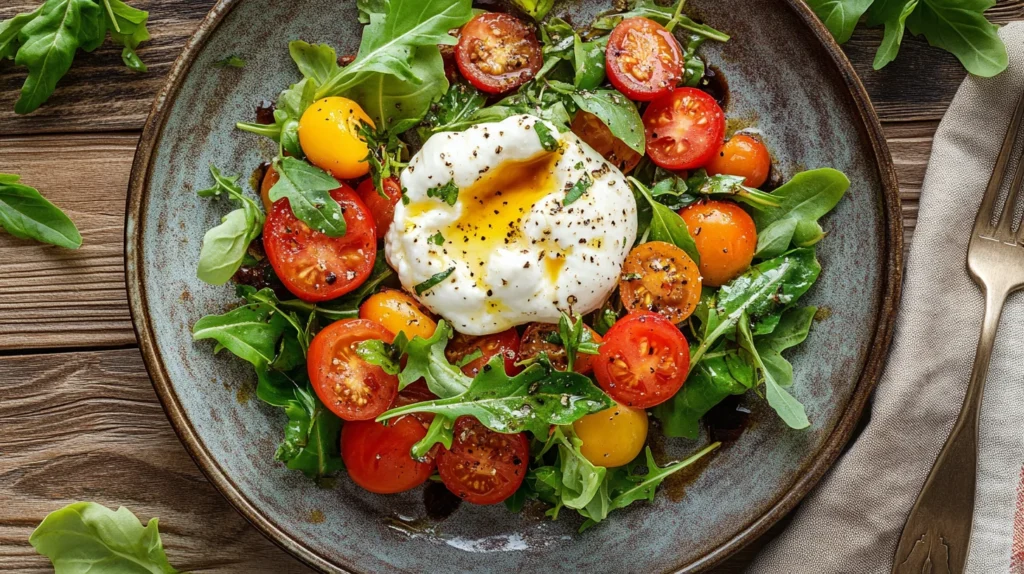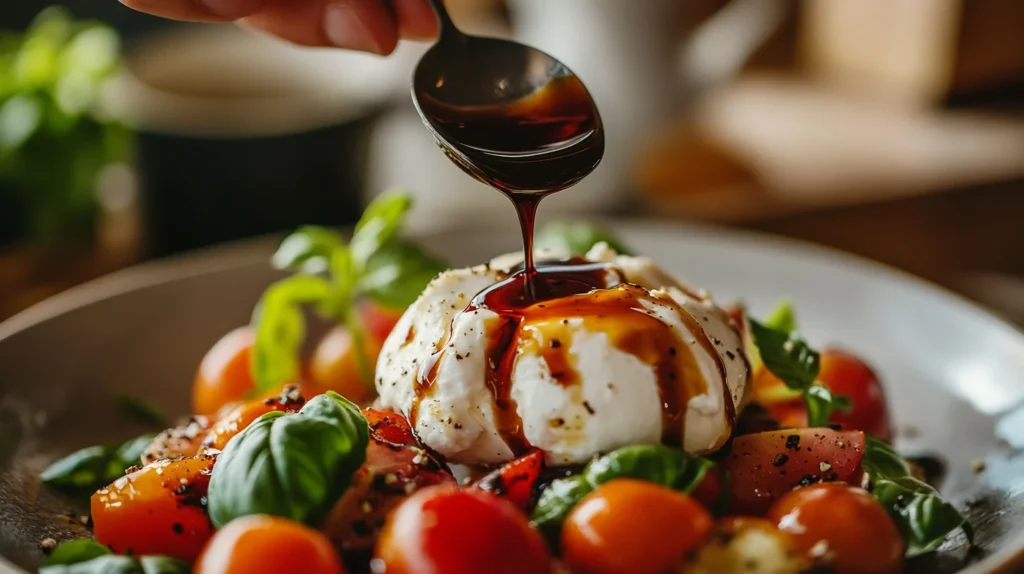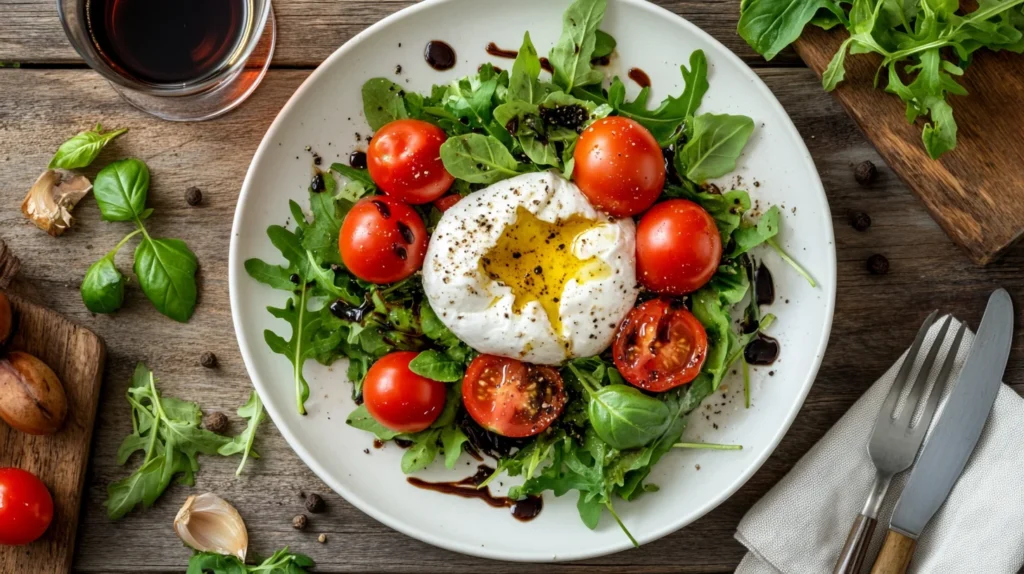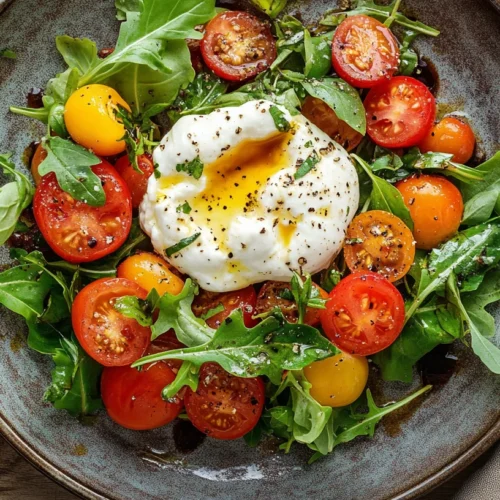Burrata salad is a favorite dish among food lovers, celebrated for its creamy texture and wide range of flavors. It comes from Italian cuisine, where burrata—a soft cheese made of mozzarella and cream—adds a rich touch to fresh ingredients. Whether you’re hosting a party or looking for a tasty yet healthy meal, burrata salad is a great option.
This guide covers everything you need to know about burrata salad, including its history, health benefits, recipe ideas, and tips for serving. By the end, you’ll know how to make a burrata salad that delights taste buds and wows your guests. Let’s get started!

What is Burrata?
Burrata is a soft Italian cheese from the Apulia (Puglia) region. Its name means “buttered” in Italian, highlighting its rich and creamy taste. Made from cow’s milk (or sometimes buffalo milk), it combines mozzarella with a soft, creamy filling called stracciatella. When cut, burrata’s creamy center oozes out, making it a delicious and fancy addition to salads.
How is Burrata Different from Mozzarella?
Though burrata and mozzarella share similarities, they are distinct cheeses:
Texture: Mozzarella is firm and elastic, while burrata has a creamy, oozing interior.
Flavor: Burrata offers a richer, buttery taste compared to mozzarella’s mild profile.
Usage: While mozzarella is versatile in cooked dishes, burrata is best served fresh to preserve its delicate texture.
Burrata’s unique qualities make it the star ingredient in salads, where its creaminess enhances fresh produce and dressings.
Health Benefits of Burrata Salad
Mixing burrata with fresh veggies and other healthy ingredients makes a dish that’s both tasty and good for you. Burrata is rich in fats, but adding it to nutrient-packed foods keeps it balanced.
Nutritional Highlights of Burrata
Protein: Burrata provides a good source of high-quality protein for muscle repair and overall body function.
Calcium: Like most dairy products, burrata supports bone health and dental strength.
Healthy Fats: Its creamy filling contains fats that provide satiety and energy.
Nutrient Boost from Ingredients
The components of burrata salad, such as fresh greens, fruits, and nuts, amplify its health benefits. For example:
Greens: Spinach and arugula are rich in antioxidants and vitamins like A, C, and K.
Fruits: Tomatoes and figs add fiber, vitamin C, and natural sweetness.
Nuts: Almonds and walnuts provide heart-healthy omega-3 fatty acids and crunch.
Role in a Balanced Diet
Burrata salad can fit into various dietary plans, from Mediterranean to low-carb. For those concerned about calories, portioning burrata wisely and emphasizing vegetables ensures a balanced plate without compromising on flavor.
Essential Ingredients for Burrata Salad
Crafting a burrata salad requires a thoughtful selection of ingredients to highlight the cheese’s creamy texture and rich flavor. While the combinations are endless, a few essential components consistently elevate the dish. Let’s break them down.
Core Ingredients for a Classic Burrata Salad
Burrata Cheese: The star of the dish, burrata is best when served fresh. Look for high-quality cheese with a soft, creamy interior.
Greens: Peppery arugula, baby spinach, or mixed greens provide a refreshing base that complements the cheese.
Fruits: Seasonal fruits like heirloom tomatoes, figs, or peaches add a natural sweetness and vibrant color.
Olive Oil: A drizzle of extra virgin olive oil enhances the dish’s richness, adding a smooth, fruity finish.
Balsamic Glaze or Vinegar: This tangy ingredient balances the creaminess of the burrata and ties the flavors together.
Additional Enhancements for Texture and Flavor
Nuts and Seeds: Toasted walnuts, pistachios, or pumpkin seeds add a satisfying crunch and nutty undertones.
Herbs: Fresh basil, mint, or chives introduce aromatic layers that complement the dish’s freshness.
Crusty Bread: Slices of toasted sourdough or a rustic baguette serve as the perfect accompaniment for scooping up cheese and dressing.
Best Greens for Burrata Salad
The right greens can make or break your burrata salad. Opt for varieties that offer distinct textures and flavors to balance the cheese’s creaminess.
Popular Greens and Their Pairings
Arugula: With its peppery bite, arugula is a classic choice that pairs wonderfully with burrata and acidic dressings.
Spinach: Baby spinach’s mild flavor allows the burrata to shine while adding a boost of nutrients.
Mixed Greens: A combination of lettuces, such as radicchio and frisée, provides a variety of textures and colors.
How to Choose the Right Greens
Seasonal Freshness: Opt for greens that are in season for the freshest flavor.
Flavor Balance: Pair delicate greens with strong dressings and bolder greens with lighter, subtler dressings.
Presentation: Layer greens as a base to create a vibrant and visually appealing salad.
By choosing greens that complement burrata, you set the stage for a perfectly balanced dish.
Fruits in Burrata Salad
Adding fruits to a burrata salad introduces sweetness, acidity, and juiciness that contrast beautifully with the cheese’s creamy richness. Fruits bring vibrant color and depth to the dish, transforming it into a show-stopping salad suitable for any occasion.
Popular Fruit Pairings for Burrata
Tomatoes: Heirloom tomatoes are a popular choice. Their sweet and tangy taste goes great with burrata, especially with some balsamic glaze. Cherry tomatoes add extra sweetness.
Figs: Fresh figs offer a honeyed sweetness and unique texture that elevates the dish. Pair them with arugula and a touch of honey for an irresistible combination.
Peaches: Grilled or fresh peaches add a juicy, caramelized sweetness that pairs wonderfully with burrata and herbs like basil or mint.
Citrus Fruits: Orange or grapefruit segments lend a refreshing zing that cuts through the cheese’s richness.
Tips for Incorporating Fruits
Seasonality: Use fruits that are in season to ensure optimal freshness and flavor.
Texture: Choose fruits with varying textures—soft peaches, juicy tomatoes, or crisp apples—to add interest to every bite.
Preparation: Slice fruits into uniform pieces to ensure even distribution throughout the salad. For a gourmet touch, grill or roast fruits like peaches or figs to deepen their flavor.
Enhancing Flavors with Dressings
The right dressing is key to blending the flavors in a burrata salad. A good dressing enhances the cheese, greens, and other ingredients without taking over.
Types of Dressings for Burrata Salad

Balsamic Glaze: A reduced balsamic vinegar drizzle is a classic pairing, offering a sweet and tangy contrast to burrata’s creaminess.
Citrus Vinaigrette: Made with lemon, orange, or grapefruit juice, this light dressing adds a refreshing brightness.
Honey and Mustard Dressing: A subtle sweetness combined with a hint of spice makes this dressing perfect for salads with fruit.
Herb-Infused Olive Oil: Simple yet flavorful, olive oil infused with basil, rosemary, or thyme complements the fresh ingredients.
Creating the Perfect Dressing at Home
Balance Flavors: Combine acid (vinegar or citrus juice), fat (olive oil), and sweeteners (honey or maple syrup) in the right proportions.
Season Well: Add salt and pepper to taste, and consider enhancing the flavor with garlic, Dijon mustard, or fresh herbs.
Emulsify: Whisk or blend your dressing to create a smooth, cohesive mixture that coats the salad evenly.
Tips for Dressing Application
Light Drizzle: Avoid drowning the salad in dressing. Start with a small amount and adjust to taste.
Timing: Dress the salad just before serving to keep the greens crisp and vibrant.
Nuts and Seeds for Added Crunch
Adding nuts and seeds to burrata salad adds texture, taste, and extra health benefits. They give a nice crunch that goes well with the creamy burrata and fresh greens.
Best Nuts and Seeds for Burrata Salad
Walnuts: Their rich, slightly bitter flavor pairs beautifully with sweet fruits like figs or peaches. Toasting walnuts intensifies their nuttiness.
Pistachios: With their vibrant green hue and mild sweetness, pistachios add both aesthetic appeal and a unique taste.
Almonds: Sliced or slivered almonds bring a subtle crunch and work well with citrus-based salads.
Pumpkin Seeds: These are perfect for autumnal salads, offering a nutty flavor that complements roasted vegetables and earthy greens.
Pine Nuts: Their buttery texture and mild flavor make them a versatile addition to Mediterranean-inspired variations.
How to Prepare Nuts and Seeds for Salads
Toasting: Toasting nuts and seeds enhances their natural flavors. Use a dry skillet over medium heat, stirring frequently to avoid burning.
Seasoning: Add a touch of sea salt, smoked paprika, or honey for an extra flavor boost.
Chopping: Roughly chop larger nuts like walnuts or almonds for even distribution and easier eating.
Nutritional Benefits of Adding Nuts and Seeds
Healthy Fats: Many nuts and seeds are rich in omega-3 and monounsaturated fats, supporting heart health.
Protein: They add plant-based protein, making the salad more filling.
Vitamins and Minerals: Nuts and seeds are excellent sources of magnesium, vitamin E, and zinc.
Creative Variations of Burrata Salad
Burrata salad is very versatile, letting you get creative with ingredients and flavors. From classic mixes to new ideas, there’s a version for everyone.
Classic Burrata Caprese
Ingredients: Burrata, ripe tomatoes, fresh basil, olive oil, balsamic glaze, and salt.
Preparation: Arrange slices of tomato and whole burrata on a platter. Drizzle with olive oil and balsamic, then garnish with fresh basil.
Why It Works: This timeless recipe celebrates simplicity and lets the quality of the ingredients shine.
Fruit-Forward Burrata Salad
Ingredients: Burrata, grilled peaches, arugula, honey, and toasted almonds.
Preparation: Combine arugula and burrata on a plate. Top with slices of grilled peaches, drizzle with honey, and sprinkle with almonds.
Why It Works: The sweetness of the peaches complements the cheese, while arugula adds a peppery bite.
Mediterranean-Style Burrata Salad
Ingredients: Burrata, roasted red peppers, olives, cucumbers, mixed greens, and herbed vinaigrette.
Preparation: Layer greens, burrata, and vegetables. Drizzle with herbed vinaigrette and sprinkle with oregano or thyme.
Why It Works: This variation highlights bold, savory flavors inspired by Mediterranean cuisine.
Autumn Burrata Salad
Ingredients: Burrata, roasted butternut squash, pomegranate seeds, arugula, and pumpkin seeds.
Preparation: Combine warm squash, burrata, and arugula on a platter. Garnish with pomegranate seeds and pumpkin seeds.
Why It Works: The earthy squash and tangy pomegranate balance the rich burrata, making it ideal for cooler months.
How to Properly Serve Burrata Salad
Serving and presenting your burrata salad well can turn it from a simple dish into something special. Handling burrata with care and plating it nicely makes it even more enjoyable.

Tips for Handling Burrata
Keep It Fresh: Burrata is best served fresh, ideally within 48 hours of purchase. Store it in the refrigerator in its original liquid until use.
Room Temperature: Allow burrata to sit at room temperature for 20-30 minutes before serving to enhance its creamy texture and flavor.
Slice Carefully: Use a sharp knife to gently cut into the burrata, revealing its creamy interior without compromising its shape.
Presentation Ideas for Burrata Salad
Platter Style: Arrange ingredients on a large platter, layering greens, fruits, and nuts with the burrata as the centerpiece.
Individual Plates: Divide the salad into personal portions for an elegant touch, ideal for dinner parties.
Rustic Look: Use a wooden board or natural elements like leaves as a base to create a rustic, Instagram-worthy presentation.
Enhancing the Dining Experience
Bread Pairings: Serve with crusty bread or crostini for scooping up the burrata and dressing.
Seasonal Touches: Add seasonal garnishes, like edible flowers in spring or roasted nuts in fall, to match the occasion.
Pairing Recommendations: Pair with wine or sparkling water to complete the meal (more on this below).
Seasonal Burrata Salad Ideas
Burrata salad can be adapted to suit any season, offering a year-round opportunity to enjoy this delicious dish.
Summer Burrata Salad
Ingredients: Burrata, heirloom tomatoes, fresh basil, peaches, arugula, and balsamic glaze.
Why It Works: The abundance of ripe, fresh produce makes summer the perfect season for light, vibrant salads.
Autumn Burrata Salad
Ingredients: Burrata, roasted sweet potatoes, cranberries, kale, and pumpkin seeds.
Why It Works: The earthy and warm flavors of fall ingredients pair well with burrata’s creamy texture.
Winter Burrata Salad
Ingredients: Burrata, blood oranges, fennel, radicchio, and pomegranate seeds.
Why It Works: Citrus fruits and hearty greens add brightness and balance during the colder months.
Spring Burrata Salad
Ingredients: Burrata, asparagus, peas, fresh mint, and a lemon vinaigrette.
Why It Works: Spring’s light and fresh ingredients complement the richness of burrata perfectly.
Pairing Burrata Salad with Wines and Drinks
Pairing your burrata salad with the right beverage can amplify the flavors and make your meal more enjoyable.
Wine Pairings
White Wines: Crisp, acidic whites like Sauvignon Blanc or Pinot Grigio balance the creaminess of burrata.
Rosé: A dry rosé offers light fruitiness that pairs beautifully with salads featuring tomatoes or fruits.
Sparkling Wine: Champagne or Prosecco adds an elegant touch, complementing both the cheese and fresh ingredients.
Non-Alcoholic Options
Sparkling Water: Add a slice of lemon or orange for a refreshing, palate-cleansing drink.
Herbal Teas: Iced tea with hints of mint or citrus pairs well with lighter, fruit-forward salads.
Mocktails: A grapefruit or cucumber-based mocktail can be a sophisticated choice for those avoiding alcohol.
Tips for the Perfect Burrata Salad
For an added twist, try pairing this salad with some crab salad. The contrasting textures and flavors create a memorable culinary experience.
If you’re serving the salad as part of a dinner menu, consider adding a hearty appetizer like barbecue shrimp to complement the lightness of the burrata.
To satisfy your guests’ sweet tooth, follow up with a quick and easy dessert like an oreo mug cake.
Frequently Asked Questions
What are some fun facts about burrata?
It’s a Cheese Inside a Cheese: Burrata is essentially a pouch of mozzarella filled with stracciatella, a creamy mixture of cheese curds and cream.
It Originated as a Solution for Leftovers: Farmers in Italy created burrata to use up leftover mozzarella curds and cream, making it a sustainable cheese.
Handmade Masterpiece: Traditional burrata is made entirely by hand, with artisans carefully forming the outer shell and filling it with creamy goodness.
Short Shelf Life: Burrata is incredibly fresh and perishable, best enjoyed within 48 hours of being made.
Not Just from Cows: While cow’s milk is most common, burrata can also be made from water buffalo milk, offering a richer flavor.
Are burrata salads good for you?
Yes, burrata salads can be good for you, especially when made with fresh, nutrient-dense ingredients. Here’s why:
Balanced Nutrition: While burrata is high in fat, pairing it with fresh vegetables, fruits, and nuts adds fiber, vitamins, and minerals, making it part of a balanced diet.
Rich in Calcium: Burrata provides calcium, essential for bone and dental health.
Healthy Fats: The fats in burrata are satisfying and provide energy. Combine it with healthy fats like olive oil for additional benefits.
Customizable: You can adjust the ingredients to suit your dietary needs, such as using more greens or low-calorie dressings.
To keep it healthy, focus on portion control and balance the rich cheese with lighter, fresh elements.
What do Italians eat burrata with?
In Italy, burrata is often served simply to highlight its flavor and freshness. Common pairings include:
Tomatoes: A classic combination, often with olive oil, basil, and a sprinkle of salt.
Bread: Crusty bread, such as focaccia or sourdough, is used to scoop up the cheese and juices.
Cured Meats: Prosciutto or salami adds a savory and salty complement to burrata.
Fresh Vegetables: Lightly roasted or fresh vegetables like zucchini, peppers, or artichokes often accompany burrata.
Fruits: Sweet fruits like figs, peaches, or melon are popular, especially in summer.
Burrata is also enjoyed as a topping for pizza, pasta, or risotto.
Do you eat the skin on burrata?
Yes, you can eat the skin of burrata! The outer layer is made of mozzarella and is fully edible. It holds the cheese together and has a firmer texture, which contrasts nicely with the creamy center. Enjoying both the skin and the inside is part of the burrata experience.
Conclusion
Burrata salad is a tasty and simple dish made with creamy cheese and fresh ingredients. Whether you love a classic Caprese or want to try new ideas, burrata salad has so many options. From choosing the right greens and fruits to pairing it with drinks and seasonal flavors, this guide helps you make burrata salad the star of any meal. Grab your ingredients, get creative, and enjoy the perfect mix of creamy and fresh flavors in every bite.

Fresh & Creamy Burrata Salad Recipe
Equipment
- Large serving plate or salad bowl
- Cutting board
- Sharp knife
- Small whisk (for dressing)
- Measuring spoons
Ingredients
- For the Salad:
- 1 large burrata cheese ball about 4 oz
- 2 cups cherry tomatoes halved (or heirloom tomatoes, sliced)
- ½ cup fresh basil leaves
- 2 cups arugula optional, for added greens
- For the Dressing:
- 3 tbsp extra virgin olive oil
- 1 tbsp balsamic glaze or balsamic reduction
- ½ tsp sea salt
- ¼ tsp black pepper
- ½ tsp red pepper flakes optional, for spice
- For Garnishing Optional:
- 2 tbsp toasted pine nuts or walnuts
- 1 tbsp crumbled feta or parmesan
- Freshly cracked black pepper
Instructions
- Step 1: Prepare the Ingredients
- Slice the tomatoes into halves or quarters.
- Arrange the arugula on a serving plate, followed by the tomatoes and fresh basil leaves.
- Place the burrata in the center of the plate, keeping it whole for an elegant presentation.
- Step 2: Make the Dressing
- In a small bowl, whisk together olive oil, balsamic glaze, sea salt, and black pepper.
- (Optional) Add red pepper flakes for extra heat.
- Step 3: Assemble the Salad
- Drizzle the dressing evenly over the salad and burrata.
- Sprinkle with toasted pine nuts, crumbled feta, or freshly cracked black pepper if desired.
- Step 4: Serve & Enjoy!
- Serve immediately by cutting into the burrata so the creamy center blends with the tomatoes and dressing.
- Pair with toasted sourdough bread or a glass of white wine for a complete experience.
Notes
Make it Vegan: Swap burrata for vegan mozzarella or avocado.
Extra Flavor: Add a drizzle of truffle oil for a gourmet touch.
Storage: If necessary, store the salad without the burrata in an airtight container for up to 24 hours.

